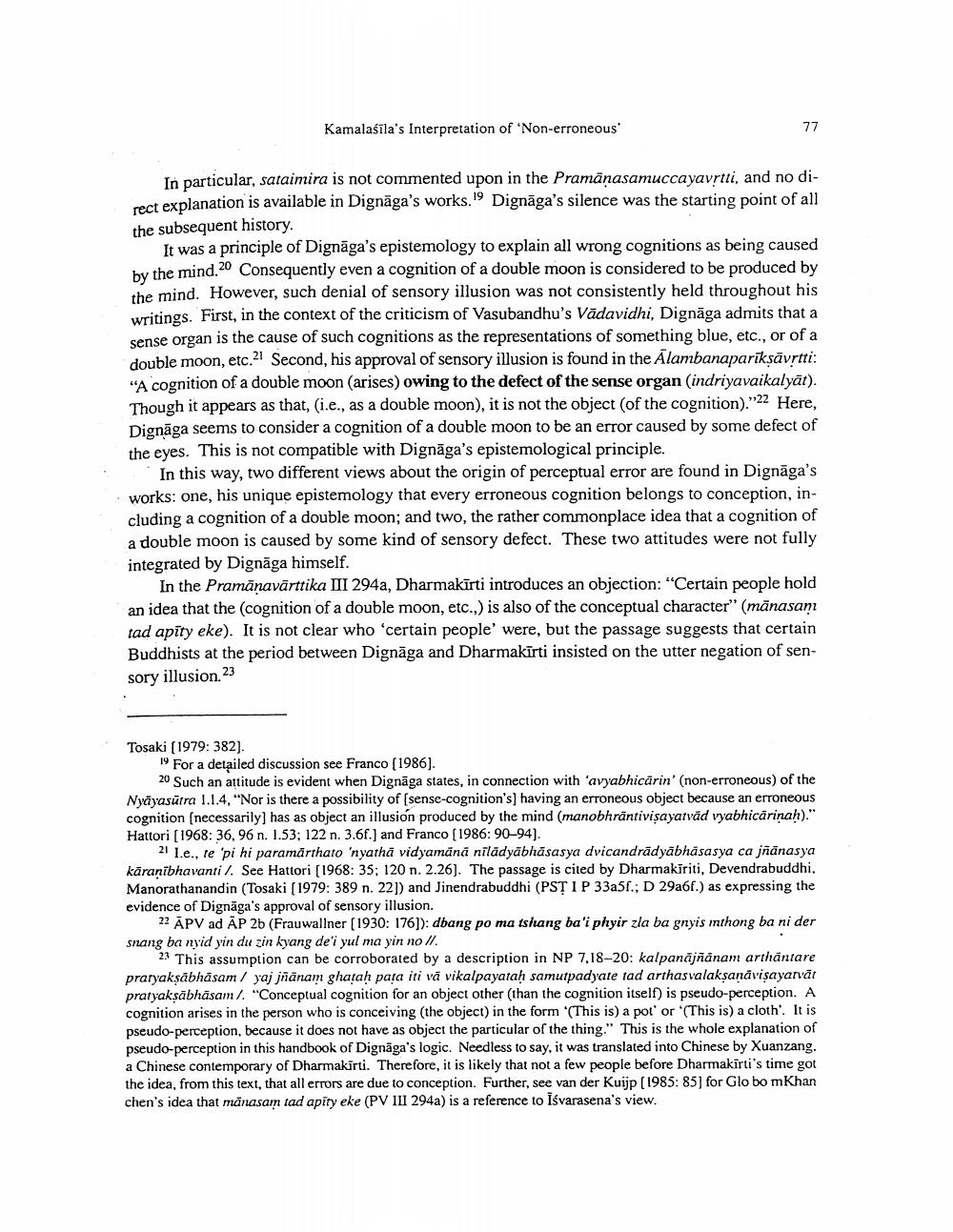________________
Kamalasila's Interpretation of 'Non-erroneous
In particular, sataimira is not commented upon in the Pramanasamuccayavrtti, and no direct explanation is available in Dignāga's works. Dignāga's silence was the starting point of all the subsequent history.
It was a principle of Dignāga's epistemology to explain all wrong cognitions as being caused by the mind.20 Consequently even a cognition of a double moon is considered to be produced by the mind. However, such denial of sensory illusion was not consistently held throughout his writings. First, in the context of the criticism of Vasubandhu's Vädavidhi, Dignāga admits that a sense organ is the cause of such cognitions as the representations of something blue, etc., or of a double moon, etc.21 Second, his approval of sensory illusion is found in the Alambanapariksavrtti: "A cognition of a double moon (arises) owing to the defect of the sense organ indriyavaikalyāt). Though it appears as that, (i.e., as a double moon), it is not the object of the cognition)."22 Here, Dignāga seems to consider a cognition of a double moon to be an error caused by some defect of the eyes. This is not compatible with Dignāga's epistemological principle.
In this way, two different views about the origin of perceptual error are found in Dignāga's works: one, his unique epistemology that every erroneous cognition belongs to conception, including a cognition of a double moon; and two, the rather commonplace idea that a cognition of a double moon is caused by some kind of sensory defect. These two attitudes were not fully integrated by Dignāga himself.
In the Pramānavārttika III 294a, Dharmakīrti introduces an objection: "Certain people hold an idea that the (cognition of a double moon, etc.,) is also of the conceptual character" (mānasam tad apīty eke). It is not clear who 'certain people' were, but the passage suggests that certain Buddhists at the period between Dignāga and Dharmakīrti insisted on the utter negation of sensory illusion.23
Tosaki (1979: 382).
19 For a detailed discussion see Franco (1986).
20 Such an attitude is evident when Dignāga states, in connection with 'avyabhicărin' (non-erroneous) of the Nyāyasūtra 1.1.4,"Nor is there a possibility of (sense-cognition's) having an erroneous object because an erroneous cognition (necessarily] has as object an illusion produced by the mind (manobhräntivişayatvād vyabhicărinah)." Hattori (1968: 36,96 n. 1.53; 122 n. 3.6f.) and Franco (1986: 90-94).
21 L.e., te 'pi hi paramarthato 'nyathā vidyamānā nīlādyābhāsasya dvicandrädyābhāsasya ca jñānasya kāranibhavanti/. See Hattori (1968: 35; 120 n. 2.26). The passage is cited by Dharmakiriti, Devendrabuddhi, Manorathanandin (Tosaki (1979: 389 n. 22]) and Jinendrabuddhi (PST I P 33a5f.; D 29a6f.) as expressing the evidence of Dignāga's approval of sensory illusion.
22 APV ad AP 2b (Frauwallner (1930: 176]): dbang po ma tshang ba'i phyir zla ba gnyis mthong ba ni der snang ba nyid yin du zin kyang de'i yul ma yin no ll.
23 This assumption can be corroborated by a description in NP 7,18-20: kalpanājñānam arthāntare pratyaksābhāsam / yaj jñānam gharah pata iti vā vikalpayatah samutpadyate tad arthasvalaksanāvisayanvāt pratyaksābhāsam/. "Conceptual cognition for an object other than the cognition itself) is pseudo-perception. A cognition arises in the person who is conceiving (the object) in the form (This is) a pot' or '(This is) a cloth'. It is pseudo-perception, because it does not have as object the particular of the thing." This is the whole explanation of pseudo-perception in this handbook of Dignāga's logic. Needless to say, it was translated into Chinese by Xuanzang. a Chinese contemporary of Dharmakirti. Therefore, it is likely that not a few people before Dharmakirti's time got the idea, from this text, that all errors are due to conception. Further, see van der Kuijp (1985: 85) for Glo bo mKhan chen's idea that mānasam tad apity eke (PV IU 294a) is a reference to Iśvarasena's view.




